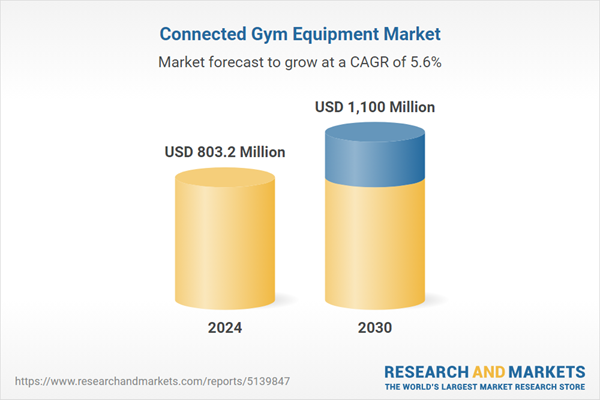The global market for Connected Gym Equipment was valued at US$803.2 Million in 2024 and is projected to reach US$1.1 Billion by 2030, growing at a CAGR of 5.6% from 2024 to 2030. This comprehensive report provides an in-depth analysis of market trends, drivers, and forecasts, helping you make informed business decisions.
Global Connected Gym Equipment Market - Key Trends and Drivers Summarized
Why Is Connected Gym Equipment Changing the Fitness Industry?
Connected gym equipment is revolutionizing the fitness industry by integrating technology into traditional workout machines, providing users with real-time data, interactive workouts, and personalized fitness experiences. With the rise of health-conscious consumers and the growing demand for fitness technology, connected gym equipment has become a game-changer. These smart devices, which include treadmills, stationary bikes, rowers, and strength-training machines, are equipped with sensors, internet connectivity, and advanced software that track a wide range of metrics such as heart rate, calories burned, speed, and distance. This data allows users to monitor their progress more accurately and tailor their workouts to meet specific fitness goals. The seamless integration of digital platforms enables users to sync their workout data with fitness apps, wearable devices, or cloud-based services, creating a holistic fitness ecosystem. Furthermore, connected gym equipment offers a more engaging workout experience through virtual coaching, immersive environments, and global leaderboards that foster competition and motivation. This technological shift is not just enhancing the user experience but also transforming how gyms operate, making connected equipment essential for modern fitness centers looking to attract and retain members.How Does Connected Gym Equipment Enhance Workout Efficiency and Personalization?
Connected gym equipment is designed to make workouts more efficient and personalized, catering to the needs of individual users in ways traditional machines cannot. By continuously collecting data on user performance, such as time spent exercising, reps completed, resistance levels, and biometric feedback, these machines offer detailed insights into each workout session. This data-driven approach allows users to better understand their progress and make adjustments in real-time, optimizing their routines for faster results. For instance, heart rate monitoring can help users stay within their target heart rate zones for optimal fat burning or endurance training. Some machines are even equipped with AI-driven programs that can automatically adjust the intensity of a workout based on the user's fitness level, ensuring that they are consistently challenged without overexertion. Personalization is a key benefit of connected gym equipment, offering customized workout plans based on an individual's fitness goals, whether it's weight loss, muscle gain, or cardiovascular endurance. With access to virtual coaching, users can receive real-time feedback and tailored advice, similar to what they might get from a personal trainer. Many connected machines also allow users to access on-demand workout classes or participate in live-streamed sessions from home, providing the same level of motivation and guidance found in a gym setting. This not only enhances the user experience but also makes fitness more accessible for people who prefer to work out in the privacy of their own homes.How Is Technology Shaping the Future of Connected Gym Equipment?
Technological advancements are pushing the boundaries of what connected gym equipment can do, with emerging trends like AI, virtual reality (VR), and machine learning creating new possibilities for the fitness industry. Artificial intelligence is increasingly being integrated into connected gym machines, enabling them to analyze a user's data over time and make intelligent adjustments to their workouts. For example, an AI-powered treadmill can analyze a user's running patterns and suggest changes in speed or incline to optimize performance and reduce the risk of injury. Machine learning algorithms can also provide personalized workout recommendations based on a user's historical performance, adjusting routines as their fitness level improves. Another transformative technology in the connected gym space is virtual reality, which is providing immersive workout experiences that transport users to different environments - whether it's running through scenic mountain trails or cycling in a virtual race with other users worldwide. This gamification of exercise not only enhances engagement but also encourages users to push harder, making workouts more enjoyable and less monotonous. Additionally, advancements in sensor technology are enabling more accurate tracking of movements and biomechanics, allowing connected gym equipment to provide real-time corrective feedback on posture and form, ensuring safer and more effective workouts. The integration of cloud-based platforms is also becoming a crucial component of connected gym equipment, allowing users to store their workout data, track their long-term progress, and access personalized fitness plans from any location. Many of these platforms are also compatible with wearable devices, enabling users to sync data across multiple fitness ecosystems.What Factors Are Driving the Growth of the Connected Gym Equipment Market?
The growth in the connected gym equipment market is driven by several key factors, including technological advancements, changing consumer preferences, and the rise of at-home fitness trends. One of the primary drivers is the increasing demand for personalized and data-driven workout experiences. As consumers become more health-conscious and fitness-focused, they are looking for solutions that not only track their performance but also provide actionable insights to help them reach their goals more efficiently. Connected gym equipment meets this need by offering real-time data tracking, virtual coaching, and tailored workout programs, which are becoming increasingly important for both individual users and fitness centers seeking to enhance the member experience. Another significant driver is the rise of at-home fitness, which has seen explosive growth. With many people seeking alternatives to traditional gyms, the demand for high-quality, connected fitness equipment that can replicate the gym experience at home has surged. The shift toward at-home fitness is expected to continue driving growth in the connected gym equipment market as consumers increasingly seek flexible, convenient workout solutions. Furthermore, the growing popularity of fitness apps, wearable devices, and health data integration is contributing to the expansion of the market. The ability to sync workout data from connected gym equipment with fitness trackers, smartphones, and cloud-based platforms allows users to manage their fitness journey in a more comprehensive and seamless way. Lastly, fitness centers are adopting connected gym equipment to stay competitive in an increasingly tech-driven market. By offering state-of-the-art machines with personalized features and immersive workout experiences, gyms can attract tech-savvy consumers and retain members through enhanced engagement and satisfaction. These factors - rising demand for personalization, the at-home fitness boom, and increasing integration of health data - are driving the growth of the connected gym equipment market and shaping the future of the fitness industry.Report Scope
The report analyzes the Connected Gym Equipment market, presented in terms of market value (US$ Thousand). The analysis covers the key segments and geographic regions outlined below.Segments
Segment (Cardiovascular Training Equipment, Strength Training Equipment, Other Segments); End-Use (Gym / Health Clubs, Commercial Users, Residential).Geographic Regions/Countries
World; United States; Canada; Japan; China; Europe (France; Germany; Italy; United Kingdom; and Rest of Europe); Asia-Pacific; Rest of World.Key Insights:
- Market Growth: Understand the significant growth trajectory of the Cardiovascular Training Equipment segment, which is expected to reach US$670.5 Million by 2030 with a CAGR of a 6.1%. The Strength Training Equipment segment is also set to grow at 5.0% CAGR over the analysis period.
- Regional Analysis: Gain insights into the U.S. market, valued at $221.4 Million in 2024, and China, forecasted to grow at an impressive 5.3% CAGR to reach $174.3 Million by 2030. Discover growth trends in other key regions, including Japan, Canada, Germany, and the Asia-Pacific.
Report Features:
- Comprehensive Market Data: Independent analysis of annual sales and market forecasts in US$ Million from 2024 to 2030.
- In-Depth Regional Analysis: Detailed insights into key markets, including the U.S., China, Japan, Canada, Europe, Asia-Pacific, Latin America, Middle East, and Africa.
- Company Profiles: Coverage of major players such as Draper, Inc., eGym GmbH, Johnson Health Tech Co., Ltd., Les Mills International Ltd., Life Fitness and more.
- Complimentary Updates: Receive free report updates for one year to keep you informed of the latest market developments.
Why You Should Buy This Report:
- Detailed Market Analysis: Access a thorough analysis of the Global Connected Gym Equipment Market, covering all major geographic regions and market segments.
- Competitive Insights: Get an overview of the competitive landscape, including the market presence of major players across different geographies.
- Future Trends and Drivers: Understand the key trends and drivers shaping the future of the Global Connected Gym Equipment Market.
- Actionable Insights: Benefit from actionable insights that can help you identify new revenue opportunities and make strategic business decisions.
Key Questions Answered:
- How is the Global Connected Gym Equipment Market expected to evolve by 2030?
- What are the main drivers and restraints affecting the market?
- Which market segments will grow the most over the forecast period?
- How will market shares for different regions and segments change by 2030?
- Who are the leading players in the market, and what are their prospects?
Some of the 42 major companies featured in this Connected Gym Equipment market report include:
- Draper, Inc.
- eGym GmbH
- Johnson Health Tech Co., Ltd.
- Les Mills International Ltd.
- Life Fitness
- Nautilus, Inc.
- Paradigm Health & Wellness
- Precor, Inc.
- Technogym SpA
Table of Contents
I. METHODOLOGYII. EXECUTIVE SUMMARY2. FOCUS ON SELECT PLAYERSIII. MARKET ANALYSISIV. COMPETITION
1. MARKET OVERVIEW
3. MARKET TRENDS & DRIVERS
4. GLOBAL MARKET PERSPECTIVE
UNITED STATES
CANADA
JAPAN
CHINA
EUROPE
FRANCE
GERMANY
ITALY
UNITED KINGDOM
REST OF EUROPE
ASIA-PACIFIC
REST OF WORLD
Companies Mentioned (Partial List)
A selection of companies mentioned in this report includes, but is not limited to:
- Draper, Inc.
- eGym GmbH
- Johnson Health Tech Co., Ltd.
- Les Mills International Ltd.
- Life Fitness
- Nautilus, Inc.
- Paradigm Health & Wellness
- Precor, Inc.
- Technogym SpA
Table Information
| Report Attribute | Details |
|---|---|
| No. of Pages | 244 |
| Published | April 2025 |
| Forecast Period | 2024 - 2030 |
| Estimated Market Value ( USD | $ 803.2 Million |
| Forecasted Market Value ( USD | $ 1100 Million |
| Compound Annual Growth Rate | 5.6% |
| Regions Covered | Global |









